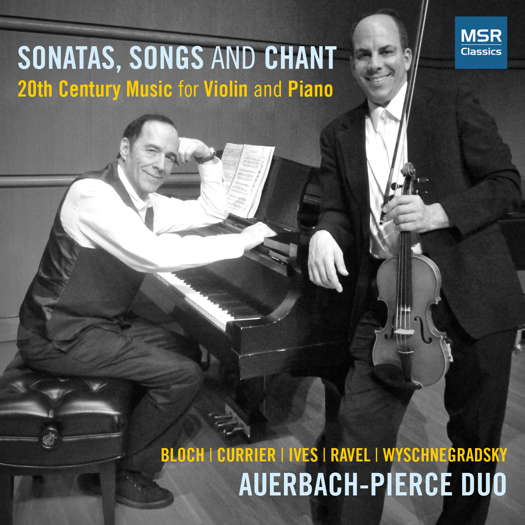- Liechtenstein
- Big Round Records LLC
- Franz Schubert
- Prince Bob
- Pappano
- Spartacus
- Igor Raykhelson
- Shlomo Mintz
 DISCUSSION: What is a work? John Dante Prevedini leads a discussion about The performing artist as co-creator, including contributions from Halida Dinova, Yekaterina Lebedeva, Béla Hartmann, David Arditti and Stephen Francis Vasta.
DISCUSSION: What is a work? John Dante Prevedini leads a discussion about The performing artist as co-creator, including contributions from Halida Dinova, Yekaterina Lebedeva, Béla Hartmann, David Arditti and Stephen Francis Vasta.
 SPONSORED: CD Spotlight. True Command - James Brawn plays Bach, Liszt, Musorgsky and Rachmaninov - recommended by Andrew Schartmann.
SPONSORED: CD Spotlight. True Command - James Brawn plays Bach, Liszt, Musorgsky and Rachmaninov - recommended by Andrew Schartmann.
All sponsored features >>

Microtonal Connections
KEITH BRAMICH listens to the Auerbach-Pierce Duo
'... nearly an hour of intriguing, sensitively played music.'
This recording, which came out a couple of months or so ago, is, I believe, the Auerbach-Pierce Duo's second album for MSR Classics. The first recording, The Devil's Trill, from 2018, received many positive reviews, including by the late Maria Nockin: '... a full tapestry of dramatic musical color ...' and by Gerald Fenech: '... scintillating performances throughout ...', and this new album is just as promising.
Aftersong by contemporary American composer and academic teacher Sebastian Currier (born 1959) begins with a fast and highly-charged intense movement which eventually runs out of steam.
Listen — Sebastian Currier: Bold (Aftersong)
(MS1748 track 1, 3:18-4:12) ℗ 2024 MSR Classics :
Without a break, this is then followed immediately by a quieter, introspective and lyrical movement which, according to Philip Borg-Wheeler's programme notes, is the 'aftersong' of the title and somehow introverted when compared to the first movement's extrovert nature.
Ernest Bloch's Nigun is the central movement of his Baal Shem Suite - three pictures of Hassidic life, named after Baal Shem Tov (or Rabbi Israel ben Eliezer), the eighteenth century founder of Hassidic Judaism. The suite is also available in a version for violin and orchestra. In Nigun, Dan Auerbach's nimble violin winds its way through this nearly seven minute melodic journey, sounding cadenza-like, improvisatory and very Jewish, supported by Joshua Pierce at the piano.
Listen — Ernest Bloch: Nigun (Baal Shem Suite)
(MS1748 track 3, 2:00-2:56) ℗ 2024 MSR Classics :
Dating from 1914 (but based on earlier material), Charles Ives' three movement Violin Sonata No 2 could be considered a late work, since the composer wrote very little after 1918.
The first movement, 'Autumn', begins slowly, and then the tempo picks up with a jolly violin tune - actually the 1797 hymn tune Autumn by French composer François-Hippolyte Barthélemon (1741-1808) - which winds up to a high-pitched climax about a third of the way through. The material is then developed, and there's another climax towards the end, before the music ends softly.
The second movement could be described as a kind of scatty barn dance, with what sound to me like oblique references to well-known tunes. Ives experiments here, as elsewhere, and the rhythm and harmony, particularly, seem to be constantly changing.
Listen — Charles Ives: In the Barn (Violin Sonata No 2)
(MS1748 track 5, 1:12-2:02) ℗ 2024 MSR Classics :
The last movement, 'The Revival', is rather haunting and slow until a much faster section well over half way through, which comes to a gradual halt during the last few bars, and then there's the most extraordinary ending which sounds more like the start of something new, but which is actually a quote from another hymn tune - Nettleton - on which the whole of this movement has in fact been based.
Russian composer Ivan Wyschnegradsky (1893-1979) lived mostly in Paris, and is mostly known for his quarter tone and other microtonal compositions. His Chant douloureux is the first movement of Chant douloureux et étude Op 6, and Wyschnegradsky's microtonal tendencies gradually become more obvious in the violin part as this piece progresses. (The piano is tuned normally, in semitones.)
Listen — Ivan Wyschnegradsky: Chant douloureux
(MS1748 track 7, 3:04-3:43) ℗ 2024 MSR Classics :
There's a further microtonal connection because the performers here - Dan Auerbach and Joshua Pierce - originally met through being involved with the New York City-based American Festival of Microtonal Music in the 1990s, and they also included microtonal music in their earlier and already mentioned 2018 album.
The last work here is also the longest - Maurice Ravel's three movement Violin Sonata No 2 (1923-7), well-known for its second movement, 'Blues'.
Listen — Maurice Ravel: Blues (Violin Sonata No 2)
(MS1748 track 9, 0:57-1:53) ℗ 2024 MSR Classics :
The first movement is lyrical and spaceous, and the sonata ends with a Perpetuum mobile, somehow connecting in my mind back to the opening track, the first movement of Currier's Aftersong.
Unusual for its repertoire - these pieces are not the most obvious twentieth century works - and notable for its fine performances by this American duo, this album provides nearly an hour of intriguing, sensitively played music.
Copyright © 6 May 2024
Keith Bramich,
London, UK



